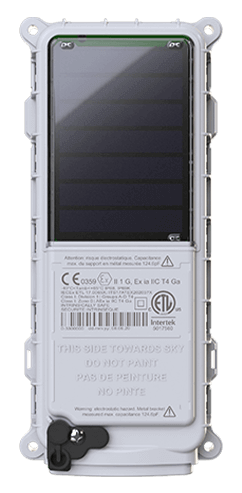Bringing IoT Wherever Customers Need It
What are the two biggest vertical markets for IoT? The answer may surprise you: transportation and utilities – and they make up more than half of all demand for IoT. Assets like these demand satellite connectivity and innovative technologies because they must operate regardless of cellular or wired coverage. Devices must connect to satellites with small, built-in antennas. They must economically transmit intermittent, short-burst data. They must be low-maintenance and have a long battery life or run on solar power, because many assets have no local power supply. They must also be inexpensive, because IoT applications require edge devices in large numbers.
Where Are My Trailers?
On any given day, more than 16 million trucks are on the road in North America, including nearly 4 million tractor-trailer big rigs that spend long periods beyond the reach of cellular. There is an average of 2 to 3 unpowered trailers for every one of those big rigs. So, trucking companies spend too much time simply locating trailers in their yard, on the road or at customer locations so they can be matched to trucks. Lack of good information on location causes them to waste money buying or leasing trailers to ensure on-time deliveries.
Globalstar’s SmartOne Solar IoT transmitter on each trailer transforms these businesses. It periodically transmits a GPS location over satellite, along with any sensor data the trucking company wants. Solar-powered, it delivers years of use with little maintenance and has enough processing power to monitor and report on battery level, confirm that it remains attached, and manage data from sensors reporting, for example, whether the trailer door is open or closed. The data transmitted over satellite feeds a cloud-based dashboard that maps the location of each trailer and provides access to sensor data. For one company managing hundreds of trailers, real-time analysis of the GPS coordinates alone showed the company that it did not need 100 trailers it was renting or a new order for 40 more. Total savings exceeded $2 million in the first year.
How Are My Tanks?
Fluid-filled tanks are part of the world’s infrastructure that usually goes unnoticed – but they are critical to industries from utilities and energy to agriculture and construction. Each represents a short-term supply of something important: propane gas for off-grid industrial or consumer use, drilling fluid for oil and gas exploration, fuel for emergency generators or water for thirsty cattle. Knowing how much is in the tank and when it needs to be refilled is critical to keeping people warm and fed, operations moving, providing backup power and the health and market value of livestock.
Technology companies have developed multiple ways to remotely measure the volume of fluid in tanks, from pressure to ultrasonics to radar. But they all depend on the ability to regularly transmit measurements to the provider for display in their web interfaces, without being able to depend on cellular connectivity. Globalstar STX and ST100 modem modules built into their systems provide a lowest-cost, highest-reliability solution.
Processing at the Edge
There is one exception to the requirement that devices be low in cost and as simple as possible. More sophisticated IoT applications can benefit from processing data in the device “at the edge.” Edge processing enables onboard AI that can respond immediately to conditions it detects, eliminating the transmission lag. It can also aggregate data and prioritize data packets, which reduce transmission volume and costs.
The right trade-off between keeping devices simple and adding edge processing depends on the application and the potential it offers for new capabilities as well as more efficient transmission. One example is monitoring of pipelines in remote areas. If a sensor detects a problematic rise or fall in pressure, edge-processing devices can open and close valves or remotely shut down pumps. Automating those decisions can make the difference between a temporary outage and a catastrophic loss. At industrial sites operating off the grid, generators provide much of their power. When sensors monitoring key factors detect a dangerous change, such as a sudden drop in oil pressure, processing in edge devices can instantly trigger an alarm and, if no human intervenes in time, switch off the generator, saving a high-cost piece of equipment. The Globalstar Integrity 150 device and ST150M modem module provide enough processing power for the job, and a combination of industry-standard hardware and a software enablement suite that speed time-to-market for new applications.
To tap the value of IoT in major verticals, from transportation to utilities, companies need connectivity and technology suited to their specialized needs. Low-cost, low-power, multimode devices that can send just the required data in short, economical messages fit the bill – and are opening up markets that can’t be served any other way.
 SmartOne Solar
SmartOne Solar SmartOne C
SmartOne C STX3
STX3 SPOT X
SPOT X SPOT Gen4
SPOT Gen4 SPOT Trace
SPOT Trace